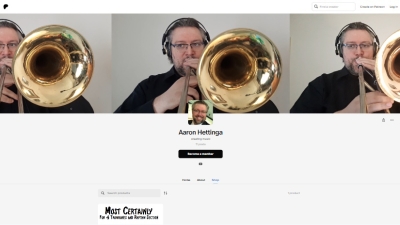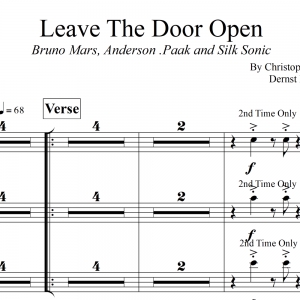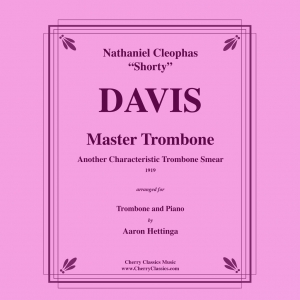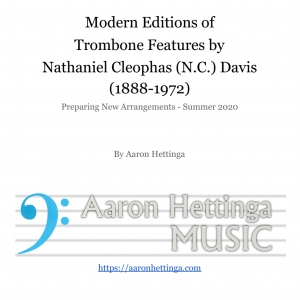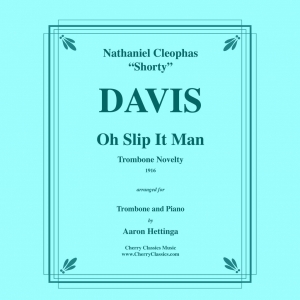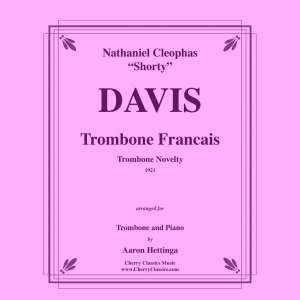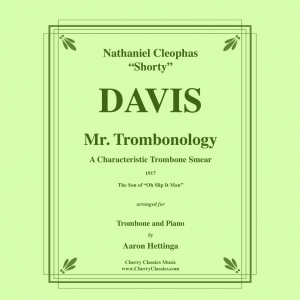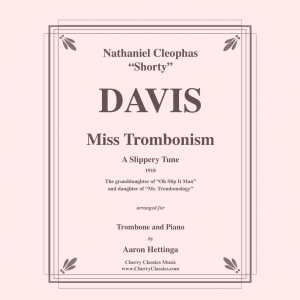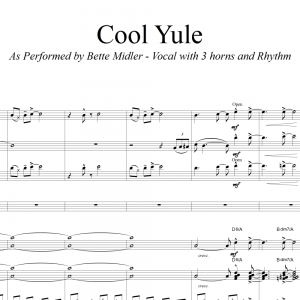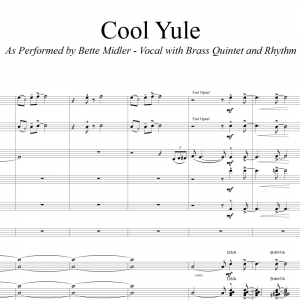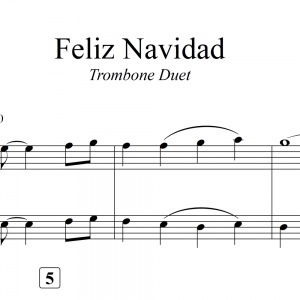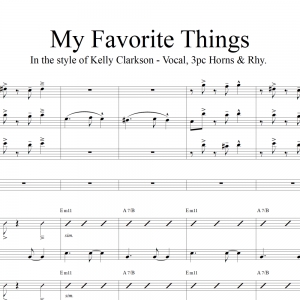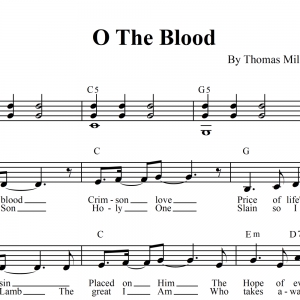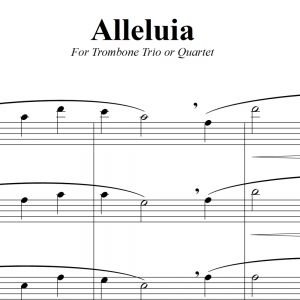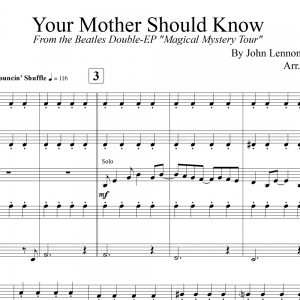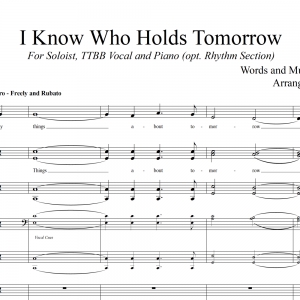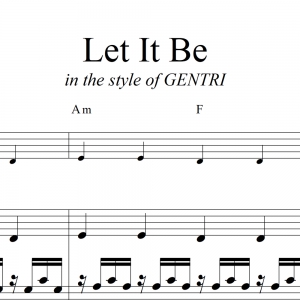
Aaron Hettinga
THE polka classic! Beer Barrel Polka is presented here in an arrangement for the instrumentation of Alford’s “Hungry Five” series of Polka band books. In this edition the popular melody gets passed around between the sections and fun accompaniment patterns sneak in from time to time to keep things interesting for players and listeners alike. The familiar TRIO section is likely to get a whole bunch of partiers singing right along with your ensemble.
Every Hungry Five band should have this chart at the ready at all times as it gets requested so often. There are no extreme range or technical challenges in this arrangement for the most part, so even fairly young ensembles could use this to include some polka fun on a German band performance. Ready to go for your Oktoberfest OomPah gig!
Also available for Rhythm Section/Vocals and 2 Horns
This fun polka classic is presented here in an arrangement for the instrumentation of Alford’s “Hungry Five” series of Polka band books. In this edition of the song, each instrument or section gets featured at some point. The brasses begin with a trumpet lead, the clarinets take over the melody for a strain, and to wrap things up even the tuba and trombone get featured solos with varying accompaniments from the remaining instruments.
There are no extreme range or technical challenges in this arrangement for the most part, so even fairly young ensembles could use this to include some polka fun on a German band performance. Ready to go for your Oktoberfest OomPah gig!
(Please note that the demo recording substitutes Soprano Sax and Trumpets for the Clarinet parts, but they still sound as written)
This arrangement of this Bruno Mars, Anderson .Paak and Silk Sonic collab gives a horn section a chance to fill up a performance of “Leave the Door Open." These horn parts play a similar role as the string section on the recording, while following the key and form of the original track to bring some extra punch to the rhythm section.
Really lifts up a live performance!
Nathaniel C. Davis was a cornetist, educator, bandleader, composer and later publisher at the N.C. Davis Music Company of Nashville, Tennessee.
During the 1910's he Taught at Nashville's Fisk university having instructed the notable trumpeter Doc Cheatham. He also taught with the Tennessee School for the Blind as well as serving as President and educator for the Traveling Conservatory of Music that he formed.
Besides leading and performing with his own N.C. Davis band, he was also known as Music Director and General Manager of the Lebanon Band and later served as music director with the Gantry Brothers Circus Band.
Davis' Trombone Family of compositions consists of 5 known pieces written for concert band between 1916 and 1921, of which Master Trombone (1919) was the fourth.
Other Nathaniel Davis works for Trombone and Piano:
- Oh Slip It Man (1916)
- Mr. Trombonology (1917)
- Miss Trombonism (1918)
- Master Trombone (1919)
- Trombone Français (1921)
Additional information on the preparation of these arrangements is available in the free download, Arranging the Works of N.C. Davis
In the summer of 2020, Aaron Hettinga did a number of arrangements of works by composer Nathaniel C. Davis.
During the course of these arranging projects, Aaron kept tabs on the nature of the work done and assembled his observations into a non-scholarly paper, posted here for free download. In this writing, there are collected observations on the style of the pieces, insights into the necessary arranging decisions and so on.
This free pdf download (below) will be of interest to those curious about Nathaniel Davis, his works, early 20th century trombone music, and arranging techniques.
Other Nathaniel Davis works for Trombone and Piano:
Nathaniel C. Davis was a cornetist, educator, bandleader, composer and later publisher at the N.C. Davis Music Company of Nashville, Tennessee.
During the 1910's he Taught at Nashville's Fisk university having instructed the notable trumpeter Doc Cheatham. He also taught with the Tennessee School for the Blind as well as serving as President and educator for the Traveling Conservatory of Music that he formed.
Besides leading and performing with his own N.C. Davis band, he was also known as Music Director and General Manager of the Lebanon Band and later served as music director with the Gantry Brothers Circus Band.
Davis' Trombone Family of compositions consists of 5 known pieces written for concert band between 1916 and 1921, of which Oh Slip It Man (1916) was the first.
Other Nathaniel Davis works for Trombone and Piano:
- Oh Slip It Man (1916)
- Mr. Trombonology (1917)
- Miss Trombonism (1918)
- Master Trombone (1919)
- Trombone Français (1921)
Additional information on the preparation of these arrangements is available in the free download, Arranging the Works of N.C. Davis
Nathaniel C. Davis was a cornetist, educator, bandleader, composer and later publisher at the N.C. Davis Music Company of Nashville, Tennessee.
During the 1910's he Taught at Nashville's Fisk university having instructed the notable trumpeter Doc Cheatham. He also taught with the Tennessee School for the Blind as well as serving as President and educator for the Traveling Conservatory of Music that he formed.
Besides leading and performing with his own N.C. Davis band, he was also known as Music Director and General Manager of the Lebanon Band and later served as music director with the Gantry Brothers Circus Band.
Davis' Trombone Family of compositions consists of 5 known pieces written for concert band between 1916 and 1921, of which Trombone Français (1921) was the last, written in tribute of his overseas service during WWI.
Other Nathaniel Davis works for Trombone and Piano:
- Oh Slip It Man (1916)
- Mr. Trombonology (1917)
- Miss Trombonism (1918)
- Master Trombone (1919)
- Trombone Français (1921)
Additional information on the preparation of these arrangements is available in the free download, Arranging the Works of N.C. Davis
Nathaniel C. Davis was a cornetist, educator, bandleader, composer and later publisher at the N.C. Davis Music Company of Nashville, Tennessee.
During the 1910's he Taught at Nashville's Fisk university having instructed the notable trumpeter Doc Cheatham. He also taught with the Tennessee School for the Blind as well as serving as President and educator for the Traveling Conservatory of Music that he formed.
Besides leading and performing with his own N.C. Davis band, he was also known as Music Director and General Manager of the Lebanon Band and later served as music director with the Gantry Brothers Circus Band.
Davis' Trombone Family of compositions consists of 5 known pieces written for concert band between 1916 and 1921, of which Mr. Trombonology (1917) was the second.
Other Nathaniel Davis works for Trombone and Piano:
- Oh Slip It Man (1916)
- Mr. Trombonology (1917)
- Miss Trombonism (1918)
- Master Trombone (1919)
- Trombone Français (1921)
Additional information on the preparation of these arrangements is available in the free download, Arranging the Works of N.C. Davis
Nathaniel C. Davis was a cornetist, educator, bandleader, composer and later publisher at the N.C. Davis Music Company of Nashville, Tennessee.
During the 1910's he Taught at Nashville's Fisk university having instructed the notable trumpeter Doc Cheatham. He also taught with the Tennessee School for the Blind as well as serving as President and educator for the Traveling Conservatory of Music that he formed.
Besides leading and performing with his own N.C. Davis band, he was also known as Music Director and General Manager of the Lebanon Band and later served as music director with the Gantry Brothers Circus Band.
Davis' Trombone Family of compositions consists of 5 known pieces written for concert band between 1916 and 1921, of which Miss Trombonism (1918) was the third.
Other Nathaniel Davis works for Trombone and Piano:
- Oh Slip It Man (1916)
- Mr. Trombonology (1917)
- Miss Trombonism (1918)
- Master Trombone (1919)
- Trombone Français (1921)
Additional information on the preparation of these arrangements is available in the free download, Arranging the Works of N.C. Davis
Bette Midler’s fun and quirky rendition of this Christmas ditty is available here as a vocal feature with 3 horns and Rhythm Section accompaniment. It follows her recording in key (D Major) and in form.
The horn section parts emulate the big band ensemble hits, providing a similar sound but with a smaller complement of players. The first trumpet part remains similar to the big band lead trumpet part rangewise. There is a small interlude that allows for a short improvised solo; chord changes are provided with all of the brass parts to feature your best soloist.
The Rhythm/Lead part works as a condensed part that gives the chord changes and general hits for rhythm players and/or conductor, but individual parts are provided for all. The Guitar and Bass parts still use slashes but the Piano part offers a fully notated option. The Percussion part (sleigh bells) is optional.
This song is always a great crowd pleaser and is a great showoff tune for your female vocalist!
Also availible for full Big Band or Brass Quintet horn sections.
Bette Midler’s fun and quirky rendition of this Christmas ditty is available here as a vocal feature with Brass Quintet and Rhythm Section accompaniment. It follows her recording in key (D Major) and in form.
Brass quintet parts emulate the big band ensemble hits, providing a similar sound but with a smaller complement of players. The first trumpet part remains similar to the big band lead trumpet part rangewise. There is a small interlude that allows for a short improvised solo; chord changes are provided with all of the brass parts to feature your best soloist.
The Rhythm/Lead part works as a condensed part that gives the chord changes and general hits for rhythm players and/or conductor, but individual parts are provided for all. The Guitar and Bass parts still use slashes but the Piano part offers a fully notated option. The Percussion part (sleigh bells) is optional.
This song is always a great crowd pleaser and is a great showoff tune for your female vocalist!
Also availible for full Big Band or reduced 3-piece horn sections
Bette Midler’s fun and quirky rendition of this Christmas ditty is available here as a vocal feature with full Big Band accompaniment. It follows her recording in key (D Major) and in form.
Lots of exciting hits and fun interplay within the ensemble. Range-wise, the first trumpet part pops out a few high E’s (concert D). There is a small interlude that varies from the string instrumentation from the recording in favor of a clarinet lead over Miller-style “Sweet” saxes. Alto 2 doubles here on clarinet.
The Rhythm/Lead part works as a condensed part that gives the chord changes and general hits for rhythm players and/or conductor, but individual parts are provided for all. The Guitar and Bass parts still use slashes but the Piano part offers a fully notated option. The Percussion part (sleigh bells) is optional.
This song is always a great crowd pleaser and is a great showoff tune for your female vocalist!
Also availible for reduced horn sections: 3-piece or Brass Quintet
Here's a fun and easily accessible arrangement of the holiday classic “Feliz Navidad” for Trombone duet. Both parts remain active throughout. The melody stays with the first part while the second part keeps interesting, at times with rhythmic accompaniment and at other times in direct harmony. This will work well with young players on either part.
Scored for 2 Tenor Trombones, Bass Trombone will work just fine on the second part as well, though nothing goes higher than the D above middle C, nor below the G at the bottom of the staff.
A great option for beginning players to enjoy playing Christmas music as duet partners!
My Favorite Things – inspired by Kelly Clarkson and arranged for 3 Horns and Rhythm Section Set in the original key of Em. Also note that the string parts are optional and the keyboard part only has chord symbols. A synth/String Reduction part is included that covers all the string parts. This is fairly easy to play though it sounds tougher on the recording.
Also available with accompaniments for 5 Brass and Full Big Band
Lead Sheet with Piano Intro and chords for the Kari Jobe / Brooklyn Tabernacle Choir song. Key of G.
This A Cappella performance by the Gatlin Brothers is presented here for trombone trio or quartet. As the Gatlin Brothers are a vocal trio, playing this arrangement without the 4th part will still remain faithful to the original performances.
Performance notes - Range: On the top end, the first part goes as high as an A-flat above the staff and the bottom part has an optional pedal A-flat as well. None of these parts present great technical challenges but present an opportunity to display ensemble section playing.
A great option for a reflective moment when used in a worship setting.
A full little tune from the Beatles’ Double-EP "Magical Mystery Tour" shows up here for 5 brass. The form and character of the original recording is generally fairly closely followed. Each instrument part gets a chance to play the melody (or interesting harmony line) for a little while to keep things interesting for all. The “stop-time” verse for the Tuba solo is a fun change-up!
Difficulty: for the most part, things don’t get very range-y other than a couple notes for the trombonist up to a high A. Otherwise, most everyone has a bit of syncopation and moving notes during their run at the melody and a fair amount of lite accompaniment otherwise. A fun lesser-known tune from the Fab Four for your quintet setlist!
Here's a fun arrangement of the traditional spiritual for Saxophone ensemble that is always well received. The melody gets passed around between the various parts of the ensemble and there's some tasty soli sections as well. A great option for those wanting a swing-band type of chart on a Sax Quintet’s program.
Scored for 2 Altos, 2 Tenors and 1 Bari Sax, the Bari gets first crack at the melody with some space for light ad-libbing around the melody before taking on a walking bass role afterward. After an improv solo opportunity for the Lead Alto, there’s a section labeled “EXTREMELY Laid Back” featuring a large shift in rhythmic and harmonic density that works best when observing the wide dynamic variations, playing really light and easy before cranking out the accented off-beat hits and coming right back down before wrapping it all up at the ending.
This chart works well with an advancing ensemble. There’s also the opportunity to keep all players focused on ensemble playing.
Also available for Mixed Brass Ensemble or Trombone Choir
This Ira Stanphill gospel standard is presented here as a feature for a Baritone or Bass vocal soloist backed with a TTBB Gospel Chorus (or Quartet) and Piano/Rhythm section Accompaniment.
Rhythm section parts are included for Piano Accompaniment, Guitar, Bass and Drums. Vocal octavo is sold separately.
Performance option: The A Cappella introduction can be bypassed if desired, making for a fully up-tempo gospel swing tune. A fine addition to any worship or song service!
Full package including Vocals, Rhtyhm Section and Lead Sheet available here
This Ira Stanphill gospel standard is presented here as a feature for a Baritone or Bass vocal soloist backed with a TTBB Gospel Chorus (or Quartet) and Piano Accompaniment. Optional rhythm section parts are available separately for Piano, Guitar, Bass and Drums.
After an A Cappella, free rubato intro, things kick off at a livelier tempo in a style inspired by recordings by The Oak Ridge Boys over the years. None of the parts are very difficult or range-intensive: the high tenor only goes as high as a G above the bass clef and the Bass line hovers around the G at the bottom of the staff with some optional low D’s and C’s.
Included parts: this package contains the Choral Octavo part only, showing the Vocal Solo, TTBB Backing Vocals, and piano accompaniment.
Performance option: The A Cappella introduction can be bypassed if desired, making for a fully up-tempo gospel swing tune. A fine addition to any worship or song service!
Full package including Vocals, Rhtyhm Section and Lead Sheet available here
This Ira Stanphill gospel standard is presented here as a feature for a Baritone or Bass vocal soloist backed with a TTBB Gospel Chorus (or Quartet) and Piano Accompaniment. Optional rhythm section parts are included for Guitar, Bass and Drums.
After an A Cappella, free rubato intro, things kick off at a livelier tempo in a style inspired by recordings by The Oak Ridge Boys over the years. None of the parts are very difficult or range-intensive: the high tenor only goes as high as a G above the bass clef and the Bass line hovers around the G at the bottom of the staff with some optional low D’s and C’s.
Included parts: there is a fully notated piano accompaniment part both freestanding and with Piano/Vocals/Chord symbols as well as with the TTBB vocals. An additional full vocal score is provided as is a free-standing TTBB vocal part. A single-line vocal solo lead sheet is also included giving many options for what’s best for your performers to use.
Performance option: The A Cappella introduction can be bypassed if desired, making for a fully up-tempo gospel swing tune. A fine addition to any worship or song service!
GENTRI version of the Beatles Classic for TTT (Trio of Tenors) in the key of C. Parts include piano with vocals, vocals, piano, bass, drums and score.
The highest tenor part requires a high A while the other two parts get up to an F.
This is a TTBB Gospel Chorus (or Quartet) with Piano Accompaniment of the hymn "I Love To Tell The Story" in a style much like was recorded by The Oak Ridge Boys on their album “Revival.” None of the parts are very difficult range-intensive, the high tenor only goes as high as an F above the bass clef and the Bass line hovers around the F at the bottom of the staff with an optional low C.
Included parts: there is a fully notated piano accompaniment part with Piano/Vocals/Chord symbols as well as a free-standing TTBB vocal part.
Performance option: This is written with a repeat back to the introduction for the second verse. This can be done with the full ensemble or could make for an opportunity for a soloist until the refrain. A fine addition to any worship service!
This setting of George Bernard's Classic Hymn, "Old Rugged Cross," for String quartet takes a completely new approach harmonically in this arrangement. While the famous melody in the 1st Violin has a few added embellishments, the rest of the ensemble joins with tighter jazz-influenced harmony.
A reflective approach to this piece of music would be extremely rewarding in a worship setting when used either as an offertory or as a lead-in to a music set. While none of the individual parts are particularly challenging, it will still be an exercise in balanced small ensemble playing.
Also available for Trombone Ensemble



